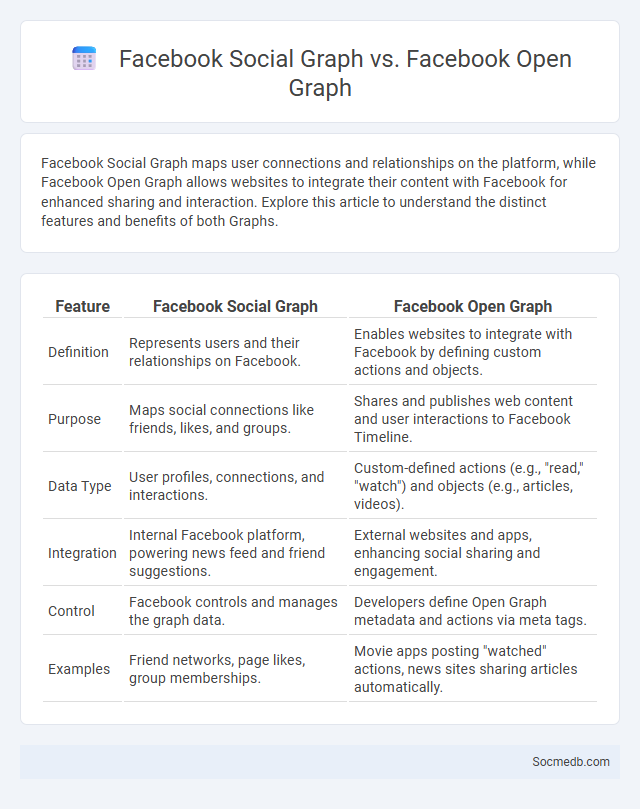
Photo illustration: Facebook Social Graph vs Facebook Open Graph
Facebook Social Graph maps user connections and relationships on the platform, while Facebook Open Graph allows websites to integrate their content with Facebook for enhanced sharing and interaction. Explore this article to understand the distinct features and benefits of both Graphs.
Table of Comparison
| Feature | Facebook Social Graph | Facebook Open Graph |
|---|---|---|
| Definition | Represents users and their relationships on Facebook. | Enables websites to integrate with Facebook by defining custom actions and objects. |
| Purpose | Maps social connections like friends, likes, and groups. | Shares and publishes web content and user interactions to Facebook Timeline. |
| Data Type | User profiles, connections, and interactions. | Custom-defined actions (e.g., "read," "watch") and objects (e.g., articles, videos). |
| Integration | Internal Facebook platform, powering news feed and friend suggestions. | External websites and apps, enhancing social sharing and engagement. |
| Control | Facebook controls and manages the graph data. | Developers define Open Graph metadata and actions via meta tags. |
| Examples | Friend networks, page likes, group memberships. | Movie apps posting "watched" actions, news sites sharing articles automatically. |
Introduction to Social Graph Concepts
The social graph represents the complex network of relationships and interactions among individuals on social media platforms, mapping connections such as friendships, followers, and shared interests. Understanding social graph concepts enables businesses and marketers to analyze user behavior, identify influencers, and optimize content reach through targeted engagement strategies. Key components include nodes representing users or entities and edges illustrating the relationships between them, facilitating advanced social network analysis.
Defining the Facebook Social Graph
The Facebook Social Graph represents the digital mapping of relationships and interactions among users on the platform, capturing connections such as friendships, likes, comments, and shared content. It serves as a dynamic database enabling personalized user experiences and targeted advertising by analyzing networked data points and interactions. Understanding the Social Graph is essential for leveraging Facebook's algorithmic capabilities to enhance social engagement and data-driven marketing strategies.
Understanding Facebook Open Graph
Facebook Open Graph enables websites to integrate deeply with Facebook's social ecosystem by using specific meta tags that control how content is displayed when shared. By implementing Open Graph protocol tags like og:title, og:description, and og:image, businesses can enhance link previews, increase user engagement, and drive higher click-through rates from Facebook. Properly configured Open Graph metadata ensures consistent branding and improves social media SEO, ultimately maximizing content visibility and interaction on the platform.
The Origins of the Social Graph
The social graph concept originated from early internet platforms like Friendster and expanded with Facebook's launch in 2004, revolutionizing how users connect online. This digital map illustrates relationships between individuals, enabling targeted communication, marketing strategies, and personalized content delivery. Integration of social graph data drives advancements in social networking algorithms and enhances user engagement across platforms.
Facebook Social Graph vs Facebook Open Graph: Key Differences
Facebook Social Graph maps real-world connections between users, friends, pages, and groups, representing the social relationships and interactions within the platform. Facebook Open Graph enables websites and apps to integrate with Facebook by allowing them to share structured metadata, improving content visibility and engagement through features like rich previews and social plugins. The Social Graph centers on user relationships, while Open Graph focuses on content sharing and external platform integration.
Use Cases for Social Graphs in Social Media
Social graphs in social media enable personalized content recommendations by mapping user connections and interactions to identify shared interests and behaviors. They facilitate targeted advertising by segmenting users based on social relationships and influence patterns, maximizing campaign relevance and engagement. Social graphs also enhance community detection and user clustering, improving platform features like friend suggestions and content moderation.
How Facebook Open Graph Extends Social Connections
Facebook Open Graph enhances social connections by allowing websites to integrate deeply with Facebook's social features, enabling users to share content, activities, and interests seamlessly across the platform. This protocol tags web content with metadata that transforms links into rich, interactive posts, increasing user engagement and facilitating real-time interactions. By leveraging Open Graph, brands and developers create personalized experiences that amplify social discovery and expand networks through mutual friends and shared experiences.
Privacy Implications of Social and Open Graphs
Social and Open Graphs collect extensive user data to enhance social connectivity and personalized experiences but often pose significant privacy risks due to data aggregation and sharing with third parties. Your digital footprint is exposed through these interconnected platforms, increasing vulnerability to unauthorized access, profiling, and identity theft. Implementing robust privacy settings and understanding data permissions is crucial to safeguard your personal information on social media networks.
Evolving Trends in Social Networking Graphs
Social networking graphs are evolving rapidly due to the increasing integration of AI-driven algorithms that enhance user interaction and community detection. The rise of multimedia content, such as videos and live streams, has also reshaped graph structures by increasing the complexity and weight of connections between users. Advanced analytics on these dynamic graphs enable better predictions of information diffusion and influence patterns within social media platforms.
Future of Social Graph Technologies and Facebook’s Role
Social graph technologies are evolving rapidly, enabling more precise mapping of user connections and interactions to enhance personalized experiences on social media platforms. Facebook continues to pioneer advancements in this space by integrating AI-driven insights and privacy-focused features to better understand and serve Your social networks. The future of social graphs will likely include deeper integration of virtual and augmented reality, transforming how users engage and connect online.
 socmedb.com
socmedb.com